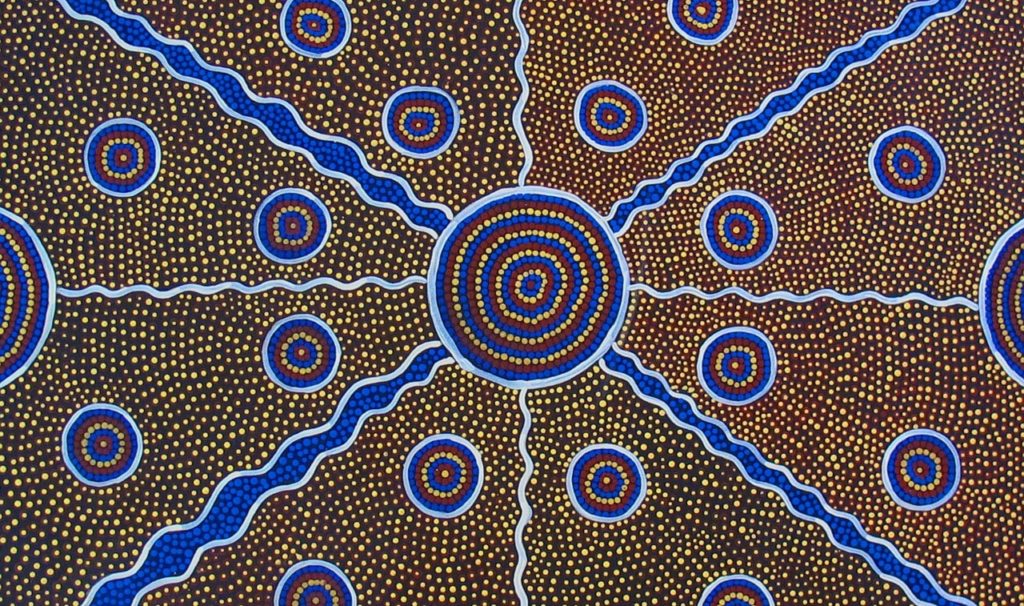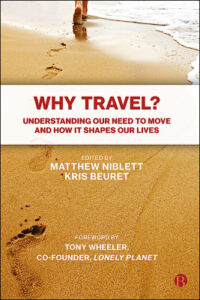Songlines: Travel, song and creation
Songlines, or Dreaming Tracks, are routes that criss-cross Australia, some running thousands of miles from coast to coast. Within the animist belief system of Indigenous Australian peoples, a songline is a path which follows the route taken by ancestral creation spirits during the Alcheringa (or Dreamtime), a “time out of time” when ancestral animal beings lived on the land. Along the paths are places which mark the actions of the ancestors: a rocky outcrop may represent an ancestor lying down, and a depression may symbolise a footprint. The paths of the songlines are recorded in traditional songs and also in stories, dance, and painting; the words, melodies and rhythms of the songs describe natural landmarks and thus enable the singer to navigate across the land.[1]
Travel is thus at the core of the belief system of Indigenous Australian peoples: it was the journeys and songs of the ancestors that brought the world into being. The songs of that belief system enable those who know them to travel across great distances without visual, written maps. Shared knowledge of various songlines also acts as a means of communication and bonding between tribes with different territories and different languages. In older times, walking the songline of your ancestors was considered by many tribes to be an essential rite of passage to maturity, necessary to become a keeper of the sacred knowledge of the tribe. Within this understanding of the world, it is the act of travelling through the land, and singing as you go, that actually brings the land into existence, recreating the original creation of the ancestors. As Bruce Chatwin explained in his classic travel narrative The Songlines: “Aboriginals could not believe the country existed until they could see and sing it.”[2]
For the Indigenous Australian peoples, travel has been a way of life for over 40,000 years, moving with the seasons and food and water sources.[3] But travel is even more than that; it is integral to their understanding of their physical and spiritual environment, and the very creation of the world. It is possible that this was true also of our human ancestors and that ancient beliefs find their echoes in the spiritual and religious belief systems of today, in which travel plays such a central role.[4] As we have discussed in previous blog posts, travel entwines with religious and spiritual beliefs in many deep and complex ways: the sacred journeys of pilgrims, the many saints and gods of travel, the wanderings of Buddha and Jesus. Religious and spiritual beliefs and practices, therefore, form one key area of investigation of the Independent Transport Commission’s Why Travel? Project; a project which explores the complex motivations that shape human travel. Examining travel from a wide range of perspectives across the arts, sciences and humanities, our aim is to better understand human travel and – crucially – to inform better decision-making about travel in to the future. For more information on the project, including expert views and current research, see www.whytravel.org.
See also
Hajj blog post
Gods and saints of travel blog post
Religion topic page
Anthropology topic page
Biology topic page
Notes
[1] Humans have long used song to pass knowledge between generations, particularly in non-literate societies. Many researchers believe that human speech may have originated in song and that species like Neanderthals (not a direct ancestor of Homo sapiens) may have communicated through song. In addition to the Indigenous Australian peoples, there are a few other groups of indigenous peoples surviving today who also use song for navigation, including the Nuu-chah-nulth group of tribes of the Pacific Northwest Coast in Canada. See for example Steven J.Mithen, The Singing Neanderthals: the Origins of Music, Language, Mind and Body, Harvard University Press, Cambridge Mass (2006); Anne Cameron, Daughters of Copper Woman, Women’s Press (1984).
[2] Bruce Chatwin, The Songlines, Random House (1987) pp.14
[3] Before they arrived in Australia (which was at the time part of an ancient super-continent that has since been split up by rising sea levels), their ancestors were among the first wave of Homo sapiens to leave Africa and travel out across the globe. The ancient migrations of our species will be discussed in chapters written by Professor Charles Pasternak and Tony Hiss in the ITC’s forthcoming book Why Travel?
[4] It seems that travel as a way of life has influenced not only the culture and psychology of Indigenous Australian Peoples but also their physiology. Research has found a genetic mutation which enables some Indigenous Australian Peoples to cope better with physical activity in a hot, arid climate: https://www.cam.ac.uk/research/news/fevered-imaginations



